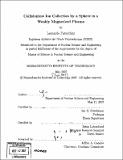| dc.contributor.advisor | Ian H. Hutchinson. | en_US |
| dc.contributor.author | Patacchini, Leonardo | en_US |
| dc.contributor.other | Massachusetts Institute of Technology. Dept. of Nuclear Science and Engineering. | en_US |
| dc.date.accessioned | 2008-04-23T14:43:03Z | |
| dc.date.available | 2008-04-23T14:43:03Z | |
| dc.date.copyright | 2007 | en_US |
| dc.date.issued | 2007 | en_US |
| dc.identifier.uri | http://hdl.handle.net/1721.1/41298 | |
| dc.description | Thesis (S.M.)--Massachusetts Institute of Technology, Dept. of Nuclear Science and Engineering, 2007. | en_US |
| dc.description | Includes bibliographical references (p. 133-135). | en_US |
| dc.description.abstract | The interaction between a probe and a plasma has been studied since the 1920s and the pioneering work of Mott-Smith and Langmuir [1], and is still today an active topic of experimental and theoretical research. Indeed an understanding of the current collection process by an electrode is relevant to diverse matters such as Langmuir and Mach-probes calibrations, dusty plasma physics, or spacecraft charging. Recent simulations relying on the ad hoc designed code SCEPTIC have fully addressed the collisionless and unmagnetized problem for a drifting collector idealized as a sphere. SCEPTIC is a 2d/3v hybrid Particle In Cell (PIC) code, in which the ion motion is fully resolved, while the electrons are treated as a Boltzmann distributed fluid [2, 3]. In the present work we tackle the transition between the unmagnetized and the weakly magnetized regime of ion collection by a spherical probe (The mean ion Larmor radius rL > rp) in a collisionless plasma (The ion mean free path Am,fp > rp). When the sphere is at space potential, we demonstrate that the ion current dependence on the background magnetic field B is linear for low B, and provide analytical expressions for this dependence. When the probe potential can not be neglected, the problem shows two distinct scale lengths: A collisionless layer of a few rp close to the probe, followed by a collisional presheath of a few AX,fp. The chosen approach is to resolve the collisionless scale-length with SCEPTIC, while using appropriate outer boundary conditions on the potential and ion distribution function to connect with the unresolved collisional presheath. We present results of our numerical simulations for a wide range of plasma parameters of direct relevance to Langmuir and Mach-probes. | en_US |
| dc.description.statementofresponsibility | by Leonardo Patacchini. | en_US |
| dc.format.extent | 135 p. | en_US |
| dc.language.iso | eng | en_US |
| dc.publisher | Massachusetts Institute of Technology | en_US |
| dc.rights | M.I.T. theses are protected by
copyright. They may be viewed from this source for any purpose, but
reproduction or distribution in any format is prohibited without written
permission. See provided URL for inquiries about permission. | en_US |
| dc.rights.uri | http://dspace.mit.edu/handle/1721.1/7582 | en_US |
| dc.subject | Nuclear Science and Engineering. | en_US |
| dc.title | Collisionless ion collection by a sphere in a weakly magnetized plasma | en_US |
| dc.type | Thesis | en_US |
| dc.description.degree | S.M. | en_US |
| dc.contributor.department | Massachusetts Institute of Technology. Department of Nuclear Science and Engineering | |
| dc.identifier.oclc | 214282918 | en_US |
